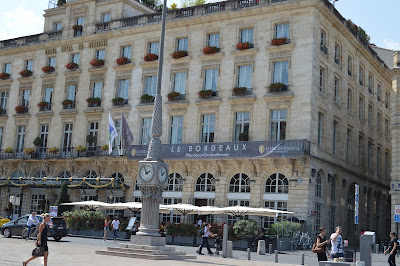 In the final months of my séjour in France I took to walking in the countryside near my lodgings. It was a way to connect to my soul-country and a way to say goodbye but it also had health benefits. It gave me a gentle tone-up physically and allowed me to just 'be' by myself, grieving the loss of my dream to stay and of having a permanent relationship with Jean-Claude.
In the final months of my séjour in France I took to walking in the countryside near my lodgings. It was a way to connect to my soul-country and a way to say goodbye but it also had health benefits. It gave me a gentle tone-up physically and allowed me to just 'be' by myself, grieving the loss of my dream to stay and of having a permanent relationship with Jean-Claude. On a good day I would clock up 4kms through villages and farmers' fields, along country highways, often past hunters and their dogs, but mostly it was pretty sleepy. Each walk I'd notice something different in the progress of crops or house renovations, architecture of houses, plants and abandoned places, plots of land for sale... houses for sale... and wish things had been otherwise and that I would have found my niche and opportunity to stay.
On a good day I would clock up 4kms through villages and farmers' fields, along country highways, often past hunters and their dogs, but mostly it was pretty sleepy. Each walk I'd notice something different in the progress of crops or house renovations, architecture of houses, plants and abandoned places, plots of land for sale... houses for sale... and wish things had been otherwise and that I would have found my niche and opportunity to stay. The only disturbing aspect was the quantity of dogs ready to savagely launch themselves against me if they ever got over the fences, Every second house seemed to have an aggressor (or several) who very audibly announced my approach. Still, it was enjoyable being somewhere pretty and always interesting where most Kiwis never go.
The only disturbing aspect was the quantity of dogs ready to savagely launch themselves against me if they ever got over the fences, Every second house seemed to have an aggressor (or several) who very audibly announced my approach. Still, it was enjoyable being somewhere pretty and always interesting where most Kiwis never go. I was saddened to see many properties with some land which was totally neglected, often literally crumbling into obscurity, uncared-for orchards where the trees were weighed down with developing apples, pears and quinces; fruit left to spoil, trees unfed, land a decaying wilderness.
I was saddened to see many properties with some land which was totally neglected, often literally crumbling into obscurity, uncared-for orchards where the trees were weighed down with developing apples, pears and quinces; fruit left to spoil, trees unfed, land a decaying wilderness.It wasn't rustic. To my gardener's eye it was a tragically missed opportunity; one I'd gladly have had for myself. Oh, the gardens I could have created in these bucolic spots.

Wandering along gently rolling landscapes with wheat, oats and barley pushing their way sunward beside me, the men on big modern tractors or harvestors turning and sowing was calming. Here I was in the cereal belt of France. Pink-stained grains left by departing farmers which the pigeons profited from were scattered down the middle of the roads.
Butterflies stopped to take a sip on wild weed flowers, some weeds I recognisd from my childhood when we all studied wild grasses and weeds at school on our uncomplicated field trips beyond the playing fields. Not many kiwi kids would recognise even four of these weeds nowdays, nor would their parents. Times have certainly changed and perhaps because of this I found much solace in walking alone and appreciating the simple things in nature.
 Nosiness often prompted me to stop and look at other people's gardens or the tradesmen who seemed to make little progress during those long summer days repairing roofs or recladding in the trendy new style of fake stonework.
Nosiness often prompted me to stop and look at other people's gardens or the tradesmen who seemed to make little progress during those long summer days repairing roofs or recladding in the trendy new style of fake stonework.It's not surprising it's growing in popularity as it really tidies up old buildings, protecting them and giving homeowners an opportunity to customise the patterns and colours yet still keep the traditional feel.
 Some of the things I will miss the most from my walks are the strong sense of history, secret stories expressed by buildings, the obligatory 'bonjour' exchanged everytime I met a total stranger, a buzzard hovering over a seemingly empty field, a hare lolloping out of harm's way over a ploughed field as I approached. I'm intensely grateful to have these experiences shared on this blog so as memories fade I can come back here and remember. It's been fun sharing my life in France with you all.
Some of the things I will miss the most from my walks are the strong sense of history, secret stories expressed by buildings, the obligatory 'bonjour' exchanged everytime I met a total stranger, a buzzard hovering over a seemingly empty field, a hare lolloping out of harm's way over a ploughed field as I approached. I'm intensely grateful to have these experiences shared on this blog so as memories fade I can come back here and remember. It's been fun sharing my life in France with you all.This blog continues, after all, To the Ends of the Earth and Francesbigadventure works in both directions. What's it like to be a repatriate? How do you build a new life back in your birth country at the other end of the planet? Stick with me and discover. The journey continues...



















































